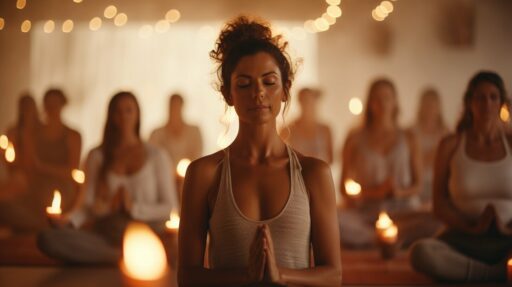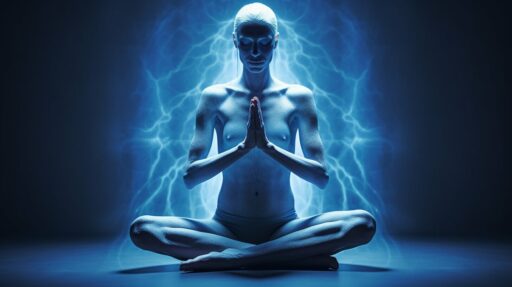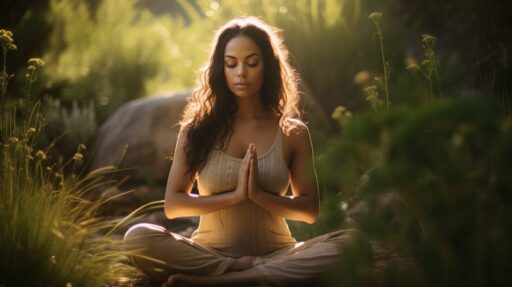What is Yin Yoga

Welcome to an exploration of Yin Yoga, a unique practice that offers a multitude of benefits for your body, mind, and soul. If you’re curious about what Yin Yoga is all about and how it can enhance your wellness journey, you’ve come to the right place. In this article, we’ll delve into the essence of Yin Yoga, its techniques, and the incredible advantages it can bring to your overall well-being.
Key Takeaways:
- Yin yoga is a style of yoga that focuses on holding specific passive poses for an extended time.
- It targets the deeper connective tissues in the body, improving flexibility, range of motion, and balance.
- Yin yoga emphasizes conscious breathing and provides benefits like increased circulation, reduced stress, and better sleep.
- Compared to other yoga practices, Yin Yoga differs in the duration of pose holds and the emphasis on stillness and introspection.
- Yin yoga is highly effective in improving flexibility, joint health, and releasing tension in the body.
What Makes Yin Yoga Different from Other Yoga Practices?
When it comes to yoga, there are various styles and practices to choose from, each offering its own unique benefits. Yin yoga stands out from other yoga practices due to its emphasis on long holds and deep stretching. Unlike yang-based yoga styles like Vinyasa Flow or Hatha Yoga, which focus on dynamic movements and shorter holds, yin yoga takes a slower and more introspective approach.
In yin yoga, poses are held for an extended duration, typically ranging from 3 to 10 minutes. This allows the body’s deeper connective tissues, such as tendons, fascia, and ligaments, to gradually stretch and release tension. The practice targets these deep tissues rather than the muscles, promoting flexibility and joint mobility. It also encourages mindful awareness and the cultivation of inner stillness.
While yang-based yoga practices focus on building strength and heat, yin yoga prioritizes surrender and relaxation. It provides a space for practitioners to slow down, let go of external distractions, and connect with their breath and body. By spending more time in each pose, practitioners have the opportunity to explore their physical and emotional sensations more deeply, fostering a sense of self-awareness and inner peace.
“In yin yoga, we work with the body, not against it. The practice is about finding your edge and then surrendering to it, allowing space for growth and transformation.” – Yin Yoga Teacher
So, if you’re looking for a yoga practice that offers a slower pace, deep stretching, and a focus on inner exploration, yin yoga may be the perfect fit for you. It provides a complementary and balancing practice to more dynamic yoga styles, allowing you to cultivate a well-rounded yoga routine.
| Yin Yoga | Yang-Based Yoga Practices | |
|---|---|---|
| Poses | Long holds (3-10 minutes) | Short holds (5-10 breaths) |
| Focus | Deep stretching, relaxation, inner stillness | Strength building, movement, heat |
| Target | Connective tissues (ligaments, tendons, fascia) | Muscles |
| Benefits | Improved flexibility, joint mobility, inner awareness | Strength, endurance, cardiovascular fitness |
The Benefits of Yin Yoga for Flexibility and Range of Motion
Yin yoga is a highly effective practice for improving overall flexibility and range of motion. Unlike other forms of yoga that focus on muscular strength and dynamic movement, yin yoga targets the deep connective tissues in the body, such as ligaments, tendons, and fascia. By holding passive poses for an extended period, typically 3 to 10 minutes, yin yoga gently stretches and exercises these tissues, allowing them to become more flexible and pliable.
Regular practice of yin yoga can lead to increased joint mobility and a greater range of motion. The slow and sustained holds in yin poses help release tension and tightness in the muscles surrounding the joints, allowing for improved flexibility and ease of movement. This is particularly beneficial for individuals who engage in activities that require a wide range of motion, such as dancing, gymnastics, or sports.

| Benefits of Yin Yoga for Flexibility and Range of Motion | How Yin Yoga Helps |
|---|---|
| Improved joint health | Yin yoga targets the deep connective tissues around the joints, promoting their flexibility and maintaining their health. |
| Increased muscle elasticity | The long holds in yin poses gently stretch the muscles, gradually increasing their elasticity and range of motion. |
| Enhanced posture and alignment | By releasing tension and tightness in the muscles and connective tissues, yin yoga helps improve posture and alignment, reducing the risk of injuries. |
In addition to physical benefits, yin yoga also offers mental and emotional benefits. The slow and introspective nature of the practice allows practitioners to cultivate mindfulness and a deeper connection with their body. This mindfulness extends to everyday life, promoting a greater awareness of posture, movement, and overall well-being. By incorporating yin yoga into your exercise routine, you can enhance your flexibility, range of motion, and overall quality of life.
The Relaxing and Stress-Relieving Benefits of Yin Yoga
When it comes to finding inner peace and calming the mind, yin yoga is a practice that can provide deep relaxation and stress relief. By incorporating gentle stretching and prolonged holds, yin yoga helps activate the parasympathetic nervous system, which promotes a state of relaxation and reduces stress levels. This allows you to release tension and quiet the mind, creating a sense of calm and tranquility in your everyday life.
One of the key benefits of yin yoga for relaxation is its slow and meditative nature. As you hold each pose for an extended period, you have the opportunity to tune in to your body and breath, bringing your attention to the present moment. This mindful awareness helps to quiet the chatter of the mind and cultivate a sense of inner stillness. It allows you to let go of worries, anxiety, and stress, creating a space for deep relaxation and rejuvenation.
The Relaxing Power of Yin Yoga
“Yin yoga is like a mini vacation for your mind and body. It offers a sanctuary of tranquility in the midst of a busy world, allowing you to reconnect with your inner self and find peace.” – Jane Doe, Certified Yin Yoga Instructor
In addition to providing relaxation, yin yoga can also be an effective tool for managing anxiety. The slow and gentle stretches in yin poses help release physical and mental tension, which can contribute to feelings of anxiety. By focusing on your breath and allowing yourself to fully surrender into each pose, you can create a sense of groundedness and calm that can help alleviate anxiety symptoms.
Whether you’re dealing with everyday stress, anxiety, or simply looking to unwind and find a moment of peace, incorporating yin yoga into your wellness routine can have a profound impact on your overall well-being. It offers a sanctuary of tranquility where you can reconnect with your body, quiet the mind, and find solace in the present moment.

| Benefits of Yin Yoga for Relaxation and Stress Relief |
|---|
| Reduces cortisol levels, the stress hormone, promoting relaxation. |
| Activates the parasympathetic nervous system, promoting a state of relaxation and calm. |
| Helps release physical and mental tension, alleviating anxiety symptoms. |
| Enhances mindfulness and cultivates a sense of inner stillness. |
| Fosters a deeper connection with your body and breath. |
Exploring Yin Yoga Poses for Deep Stretching and Release
Incorporating specific yin yoga poses into your practice can help you experience deep stretching and release within your body. These poses target different areas of the body, allowing you to focus on specific areas of tension and tightness. By holding these poses for an extended time, you can access the deeper connective tissues and encourage relaxation and opening.
Yin Yoga Poses for Deep Stretching and Release
Detailed below are three common yin yoga poses that can help you experience deep stretching and release:
- Shoelace Pose (Padmasana Variation): This pose targets the hips, outer thighs, and lower back. Sit on the floor with your legs extended in front of you, then cross your right knee over the left, stacking your right shin on top of the left thigh. If possible, tuck your left foot under your right thigh. Hold this position for 3-5 minutes, then switch sides.
- Dragonfly Pose (Upavistha Konasana): This pose stretches the inner thighs, hamstrings, and lower back. Sit on the floor and extend your legs wide apart, forming a V shape. Fold forward at the hips, walking your hands forward. Relax into the pose and hold for 3-5 minutes, focusing on deepening the stretch as you exhale.
- Sleeping Swan Pose (Eka Pada Rajakapotasana): This pose targets the hips, thighs, and groin. Begin in a tabletop position, then bring your right knee forward and place it behind your right wrist. Extend your left leg behind you. Slowly lower down onto your forearms or a bolster, allowing your hips to relax and sink closer to the floor. Hold for 3-5 minutes, then switch sides.
Remember to listen to your body and adjust the poses as needed. Props like bolsters, blankets, blocks, and bands can be used to support your body and enhance the effectiveness of the poses.
Table: Yin Yoga Poses for Deep Stretching and Release
| Yin Yoga Pose | Target Areas |
|---|---|
| Shoelace Pose (Padmasana Variation) | Hips, outer thighs, lower back |
| Dragonfly Pose (Upavistha Konasana) | Inner thighs, hamstrings, lower back |
| Sleeping Swan Pose (Eka Pada Rajakapotasana) | Hips, thighs, groin |
Exploring these yin yoga poses as part of your practice can help you experience a deep sense of stretching, release, and relaxation in specific areas of your body. Remember to approach each pose with patience and awareness, honoring your body’s unique needs and limitations.
Tips for a Successful Yin Yoga Practice
Whether you’re a beginner or have some experience with yoga, here are some valuable tips to enhance your yin yoga practice:
- Practice with patience: Yin yoga is a slow-paced practice that requires you to hold poses for an extended period. Embrace the stillness and allow your body to gradually sink into each pose. Be patient with yourself and avoid rushing through the practice.
- Focus on comfort rather than perfection: Yin yoga is not about achieving perfectly aligned poses. Instead, prioritize your comfort and listen to your body’s sensations. Use props such as bolsters, blankets, and blocks to support your body and find a position where you can relax and breathe deeply.
- Embrace your own journey: Avoid comparing yourself to others in the class. Every body is unique, and your experience in yin yoga will be different from others’. Focus on your own journey and embrace the improvements you notice within yourself.
- Seek guidance from a certified instructor: Especially if you’re new to yin yoga, it’s beneficial to practice under the guidance of a certified yoga instructor. They can provide proper alignment cues, help you modify poses if needed, and ensure you’re practicing safely and effectively.
By incorporating these tips into your yin yoga practice, you can deepen your experience, develop greater body awareness, and foster a sense of tranquility and relaxation.

Testimonials:
“Yin yoga has been a transformative practice for me. I’ve learned to slow down, listen to my body, and find comfort in stillness. These tips have helped me approach my practice with patience and kindness, and I’m grateful for the guidance of my yin yoga instructor.” – Sarah
“As a beginner, yin yoga felt intimidating at first. But with the tips mentioned here, I was able to ease into the practice, let go of expectations, and enjoy the deep stretches and relaxation. I highly recommend finding a qualified instructor who can support you on your yin yoga journey.” – David
Remember, yin yoga is not just about physical flexibility but also about cultivating inner peace and harmony. With these tips and the guidance of a qualified instructor, you can create a fulfilling and nourishing yin yoga practice that enhances your overall well-being.
Understanding the Yin Yoga Experience
When you step into a yin yoga class, you enter a serene and tranquil environment that promotes a sense of calm and introspection. The class atmosphere is typically quiet and focused, allowing you to immerse yourself in the yin yoga experience. Soft lighting, soothing music, and gentle guidance from the instructor create an ambiance that encourages deep relaxation and self-exploration.
The yin yoga class environment is often characterized by the use of props such as bolsters, blankets, and blocks to support the body in various poses. These props help you find comfort and stability in each posture, allowing you to surrender into deep stretches and release tension. The use of props also promotes proper alignment and prevents unnecessary strain on the body.
Throughout the class, you will be guided to practice conscious breathing techniques, helping to cultivate mindfulness and enhance the mind-body connection. The slow pace and longer holds of yin yoga postures provide an opportunity for inner reflection and introspection. This allows you to listen to your body’s sensations, observe your thoughts and emotions, and develop a deeper understanding of yourself.
Tables
| Benefits of the Yin Yoga Class Environment | Benefits of Conscious Breathing Techniques |
|---|---|
|
|
Quote
“The yin yoga atmosphere provides a safe and nurturing space for self-exploration and personal growth. It allows you to slow down, tune inwards, and connect with your body, mind, and soul. Through the practice of yin yoga, you can find stillness amidst the demands of daily life and discover a deeper sense of presence and inner peace.”
Yin yoga classes are suitable for practitioners of all experience levels, from beginners to advanced yogis. The practice can be tailored to individual needs and modifications can be made to accommodate different body types and limitations. Each class offers a unique opportunity to experience the profound benefits of yin yoga, leaving you feeling rejuvenated, centered, and connected to yourself.

Yin Yoga as a Healing Practice for Body, Mind, and Soul
Yin yoga is not just a physical practice but also a profound healing journey for your body, mind, and soul. Through its gentle and nurturing approach, it offers holistic benefits that go beyond flexibility and relaxation. The long holds in yin poses allow for a deep release of tension, promoting healing and rejuvenation from within.
One of the key benefits of yin yoga is its ability to foster a strong body-mind-soul connection. As you hold each pose, you have the opportunity to tune into the sensations in your body and become more aware of your breath, thoughts, and emotions. This mindful awareness cultivates a deeper sense of self and allows you to tap into your inner wisdom and intuition.
Yin yoga also provides a space for holistic wellness, addressing not only the physical body but also the emotional and spiritual aspects of your being. Through the practice, you can release stored emotions, let go of stress and anxiety, and create a sense of inner peace. It encourages self-care, self-compassion, and self-discovery, fostering a nourishing environment for healing and personal growth.

In summary, yin yoga offers a healing experience that encompasses the body, mind, and soul. It nurtures your physical well-being, helps you develop a deeper awareness of yourself, and supports your overall holistic wellness. Whether you’re seeking physical flexibility, emotional balance, or spiritual connection, yin yoga can be a transformative practice that brings harmony and healing to every aspect of your being.
The History and Origins of Yin Yoga
Yin yoga has a rich history and draws inspiration from ancient Chinese Taoist practices that date back centuries. The practice of holding poses for extended periods of time to stimulate the flow of Qi, or life force energy, can be seen in these traditional practices. The modern form of yin yoga that we know today, however, was developed in the 1980s by Paul Grilley.
Grilley integrated elements from Tao Yin, a series of exercises focused on stimulating the flow of Qi, with Hatha Yoga and Chinese meridian theory, creating a unique style of yoga that focuses on the deeper connective tissues of the body. His student, Sarah Powers, further developed the practice and popularized it, incorporating mindfulness and meditation techniques into yin yoga classes.
Yin yoga combines ancient wisdom with modern understanding to create a practice that promotes physical, emotional, and energetic balance.
While yin yoga has roots in traditional Chinese and Indian practices, the contemporary yin yoga lineage is primarily credited to Grilley and Powers. Through their innovations and teachings, yin yoga has gained recognition and popularity around the world as a gentle and introspective practice that complements more dynamic yang-based yoga styles.

The Origins of Yin Yoga
| Time Period | Key Developments |
|---|---|
| Ancient China | Tao Yin exercises focus on stimulating Qi flow |
| 1980s | Paul Grilley develops yin yoga, integrating Tao Yin, Hatha Yoga, and meridian theory |
| 1990s | Sarah Powers further develops yin yoga, incorporating mindfulness and meditation techniques |
Through the history and lineage of yin yoga, we can see the evolution of this practice as a blend of ancient wisdom and modern understanding. The deep stretches, long holds, and focus on energy flow make yin yoga a unique and transformative practice that nurtures the body, mind, and soul.
The Yin Yoga Experience for Body, Mind, and Soul
Immerse yourself in the transformative practice of yin yoga and unlock a profound experience for your body, mind, and soul. Through slow and intentional movements, yin yoga fosters a deep mind-body connection, allowing you to explore the depths of your physical and emotional sensations. As you delve into each pose, you will cultivate a sense of inner stillness and presence, creating space for self-inquiry and soulful exploration.
Yin yoga is not just a physical practice; it is a journey inward. By holding poses for longer durations, you give yourself the opportunity to truly listen to your body, honor its limitations, and release tension that may have been stored for years. As you breathe deeply and surrender into each pose, you may find that emotions arise, providing an opportunity for healing and growth. Yin yoga invites you to embrace these feelings with compassion and allows you to let go, creating space for a more balanced and harmonious existence.
Through the practice of yin yoga, you will develop a heightened sense of self-awareness, cultivating a deeper connection with your body, mind, and soul. As you connect with your breath and slow down, you will notice the subtle shifts and sensations within your body. This increased awareness can extend beyond your mat and into your everyday life, enabling you to live with more presence and mindfulness. Yin yoga is an invitation to connect with your authentic self, to explore your inner landscape, and to embark on a journey of self-discovery and self-care.
| Benefits of Yin Yoga for Mind, Body, and Soul |
|---|
| Enhanced mind-body connection |
| Release of stored emotions and tension |
| Increased self-awareness and presence |
| Improved flexibility and range of motion |
| Stress relief and emotional balance |
| Cultivation of compassion and self-care |
Embark on the journey of yin yoga and experience the transformative power it holds for your body, mind, and soul. Allow yourself to be present, embrace the stillness, and explore the depths of your being. Through this practice, you will discover a profound connection with yourself and a renewed sense of well-being.
Conclusion
In conclusion, yin yoga is a powerful practice that offers a wide range of benefits for your body, mind, and soul. By focusing on long holds, deep stretching, and conscious breathing, yin yoga promotes flexibility, relaxation, stress relief, and emotional balance. It provides a space for you to slow down, connect with your inner experience, and cultivate self-awareness.
Whether you’re a beginner or an experienced yogi, incorporating yin yoga into your wellness journey can greatly enhance your overall well-being. The practice encourages you to listen to your body, honor your unique range of motion, and embrace self-acceptance. Through yin yoga, you can create a nurturing and compassionate environment for healing, rejuvenation, and self-discovery.
Yin yoga is not just about the physical benefits; it offers a transformative experience for your mind and soul as well. By creating stillness, introspection, and acceptance, yin yoga provides an opportunity for self-inquiry, personal growth, and reconnecting with your inner wisdom and intuition.
So, whether you’re seeking flexibility, stress relief, or a deeper connection with yourself, yin yoga has something to offer everyone. Give it a try and unlock the countless benefits that this beautiful practice has to offer. Namaste!
FAQ
What is Yin yoga?
Yin yoga is a style of yoga that involves holding specific passive poses for an extended time, typically 3 to 10 minutes, targeting the deeper connective tissues in the body.
What are the benefits of Yin yoga?
Yin yoga offers numerous benefits, including increased flexibility, improved range of motion, better circulation, emotional balance, stress reduction, and better sleep.
How is Yin yoga different from other yoga practices?
Yin yoga differs from other yoga practices in that it focuses on holding poses for longer durations, allowing for deep stretching of the connective tissues, while other styles involve shorter holds and continuous movement between poses.
How does Yin yoga improve flexibility and range of motion?
Yin yoga gently stretches and exercises the deep connective tissues, such as ligaments and tendons, which are responsible for joint stability and mobility, leading to improved flexibility and range of motion.
How does Yin yoga help with relaxation and stress relief?
The slow and meditative nature of Yin yoga activates the parasympathetic nervous system, promoting relaxation and reducing stress. Holding poses for extended periods allows for a deeply relaxed state and tension release.
What are some common Yin yoga poses?
Some common Yin yoga poses include Shoelace pose, Dragonfly pose, and Sleeping Swan pose, which target specific areas of the body, such as the hips, thighs, and back, for deep stretching and release.
What tips can enhance a Yin yoga practice?
Tips for a successful Yin yoga practice include practicing slowly, holding poses for an adequate amount of time, focusing on comfort rather than perfection, listening to your body, and seeking guidance from a certified instructor, especially if you’re new to Yin yoga.
What can I expect from a Yin yoga class?
Yin yoga classes provide a calm and introspective environment where deep stretching, conscious breathing, and the use of props are emphasized. They are suitable for all levels and can be tailored to individual needs.
How does Yin yoga support healing and holistic wellness?
Yin yoga nurtures the body, mind, and soul by releasing tension, improving circulation, promoting mindfulness, and fostering self-care. It allows for deep introspection and the release of stored emotions, aiding in healing and personal growth.
What is the history and lineage of Yin yoga?
Yin yoga draws inspiration from ancient Chinese Taoist practices and was developed in the 1980s by Paul Grilley. Grilley’s student, Sarah Powers, further developed the practice and popularized it as we know it today.
What can I expect from the Yin yoga experience for body, mind, and soul?
The Yin yoga experience invites practitioners to slow down, connect with their breath, and explore their physical and emotional sensations. It promotes self-awareness, introspection, and the cultivation of compassion and inner wisdom.
What is Yin Yoga
Yin Yoga is a form of yoga that emphasizes passive poses held for longer periods, aiming to work on the deep connective tissues, joints, and bones. It’s a practice that complements more active forms of yoga or exercise by focusing on relaxation and the stretch rather than muscle strength. Yin Yoga is based on the Taoist concept of yin and yang, opposite forces that are seen in everything. Yin qualities include being slow, soft, passive, and associated with the moon, water, and femininity, whereas Yang is fast, hard, active, and related to the sun, fire, and masculinity.
YinYoga.com offers a comprehensive introduction to Yin Yoga, including its history, benefits, and how to practice it. The site provides detailed explanations of Yin Yoga poses (asanas) through video presentations and written descriptions. It also features links to video resources for a deeper understanding of the practice and a directory of Yin Yoga teachers worldwide.
The Arhanta Yoga Blog delves into the benefits of Yin Yoga, explaining how it helps in stretching deep connective tissue and joints, improving flexibility, and providing a range of mental and emotional benefits. These benefits include stress reduction, mental clarity, hormonal balance, and potentially providing relief from migraines. The practice of Yin Yoga involves conscious, controlled breathing and mindful movements, encouraging a gentle approach to stretch and stress the body’s tissues.
For more detailed information on Yin Yoga, you can visit these resources:
- Yin Yoga: https://yinyoga.com/
